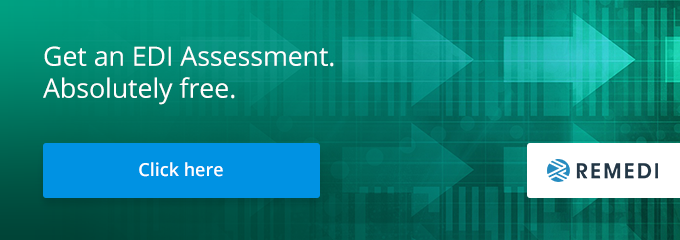
Recent supply chain disruptions have fueled a dramatic rise in demand for more agile and adaptable EDI integrations. Today, trading partners want to interact in an ecosystem that guarantees fast and reliable data transfer, regardless of the data hosting infrastructures they use.
Hybrid integration is the answer to these calls for heightened EDI flexibility. Hybrid EDI allows you to connect two or more data sources, systems, or applications and establish seamless information flow from one company to another, regardless of whether they are using cloud or on-premise hosting.
Gartner predicts that by 2022, at least 65% of large organizations will have deployed hybrid integration platforms for their digital transformation.
If you are curious about hybrid EDI, you have come to the right place. This article discusses hybrid integration's role in current business environments and how a hybrid EDI platform fits your digital transformation strategy.
What Is Hybrid Integration?
One of the primary requirements for today's enterprises is reliable real-time information sharing. Your business needs to establish robust connections between all business-critical data systems, both internally and externally, to enable seamless data exchange with your partners.
Hybrid EDI integration creates information exchanges between two or more disparate applications, be they on-premise or cloud-based.
In general, hybrid EDI solutions;
- Provide the same functionalities as conventional integration but at a much broader, all-encompassing scale.
- Interface a vast array of components to enable fluid inbound and outbound data exchange.
- Uses advanced translation tools to ensure all systems receive information in the right formats.
- Include process orchestration functionalities to enable content-based routing.
- Utilizes advanced monitoring tools to ensure all integrated systems operate as required and quickly alert relevant personnel to fix errors.
When creating hybrid EDI integration, architects focus on establishing integration orchestration and transformation that encompass all integrated applications, regardless of their nature. This approach enables solutions to be developed, managed, and updated separately without requiring a complete system shut-down.
The Role of Hybrid EDI Integration in Digital Transformation
As cloud and SaaS technologies become more relevant and B2B integrations more complex, enterprises need tools that can facilitate real-time, accurate information sharing between different systems and architectures.
The primary benefit of hybrid EDI is that it enables B2B transactions with much less infrastructural limitations than conventional EDI. Businesses that invest in hybrid integration platforms reap superior automation rewards through enhanced visibility over a diverse range of business partner transactions.
Data management improvements are a crucial milestone in any digital transformation strategy. Because hybrid integration facilitates real-time access to information, it fits right into your transformation plan. Below are three compelling ways hybrid EDI enables robust digital transformation.
- Data Accuracy
Hybrid EDI integration eliminates the need for manual data entry even when different transmission systems are involved. By nature, manual entry is plagued by errors. Creating versatile automated data flows prevents mistakes, keeping you EDI compliant, regardless of your partners' data management infrastructure.
- Faster business cycles
Hybrid integration increases data transfer speeds by eliminating translation and reformatting processes. As a result, you can communicate faster with your trading partners and significantly reduce order-to-shipment cycles.
- Partner visibility
When done right, hybrid EDI streamlines data transfer to the point where you no longer need to worry about when or how information gets to your partner. Instead, you can concentrate on your other digital transformation actions with the assurance that the data you will use is accurate, automated, and easily accessible.
Do You Need a Hybrid Integration Platform?
A successful hybrid integration starts by determining whether you need one in the first place. If your supply chain encompasses various partners, the chances are high that they could be using EDI infrastructure that is different from yours.
According to Gartner, traditional integration tools are often incapable of addressing the complexities of dynamic, multi-tiered supply chains.
Hybrid integration platforms establish data integration in different domains and can integrate any endpoints, be they on-premise systems, cloud-based applications, or even IoT devices. As a result, trading partners can use EDI to send and receive information seamlessly and in real-time.
Below are five indicators that your enterprise needs to implement a hybrid EDI platform.
- Your partners have different systems hosted on-premise and on the cloud.
- Your data is in on-premise and cloud siloes that must be broken down to enable seamless information sharing.
- Your supply chain demands more agility and innovation, which can only be achieved by establishing the system integrations necessary to take full advantage of data and analytics.
- You need access to real-time data, rather than batch processes, to respond faster to disruptions and meet changing customer needs effectively.
- You want to broaden the scope of your EDI integration to encompass more business process networks, partners, subsidiaries, cloud services, mobile apps, IoT devices, and so on, and manage every integration without hiccups.
If you are already using EDI data transfer, investing in a hybrid integration platform opens your system's compatibility to a broader range of current and future solutions, giving you a formidable competitive advantage.
Remedi Can Help You Deploy a Hybrid EDI Integration Platform
Today, cloud applications have become unavoidable in business operations. However, on-premises legacy technologies are still being widely used to transfer data among trading partners. Connecting these different applications presents significant challenges, most notably the complexities of dealing with the various data standards and protocols.
Hybrid EDI enables cloud-based and on-premise systems to talk to each other. With a hybrid integration platform, you can integrate disparate data sources and achieve the connected supply chain you need to wade through challenging times.
Remedi is the global leader in EDI integrations, with a host of flexible, scalable solutions to help enterprises make the best use of EDI. We deliver on-premise, cloud, IPaaS, and hybrid integrations that meet clients right at their points of need.
Get in touch with a Remedi expert and let us help you deploy the hybrid integration platform you need to execute your digital transformation strategy.



